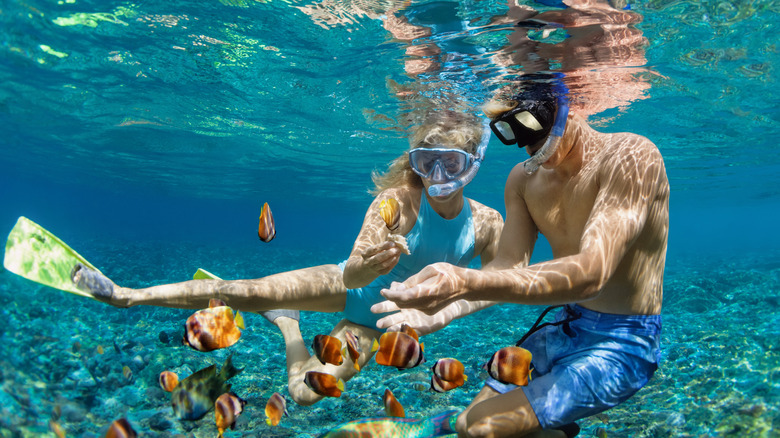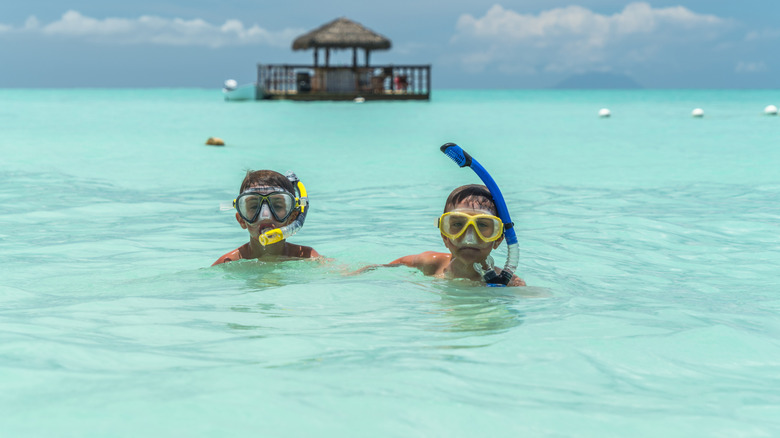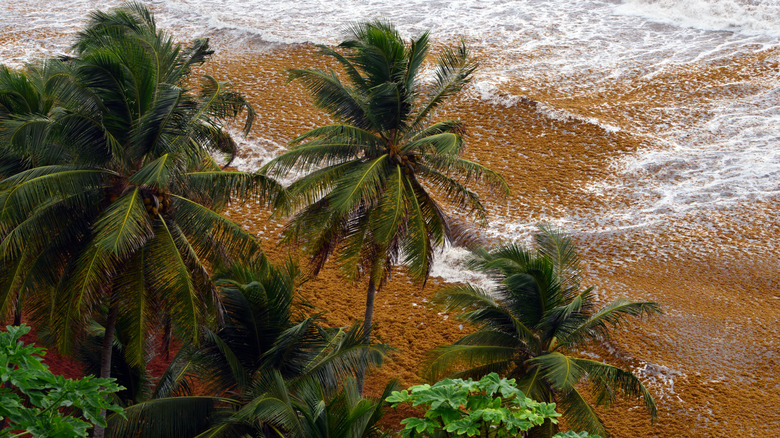The Best (And Worst) Months For Snorkeling In The Caribbean
Have you really been to the Caribbean if you haven't waddled down to the water and flopped into the shallows for a bit of snorkeling? The answer is obviously "no." Thanks to its unforgettable turquoise waters, the sun-soaked region from Cancun to the Virgin Islands is home to some of the best islands for snorkeling. But it's not always as simple as that. The Caribbean has a volatile weather system, so it's imperative for both safety and enjoyment to understand which months are better and worse for snorkeling here.
Before explaining further, it's helpful to know why the Caribbean waters are so perfect for snorkeling. While many think it's as simple as clean water and sunshine, other factors like geology, meteorology, and optics also play a role. First, that stunning turquoise color stems from a phenomenon called Rayleigh scattering, by which (to simplify it considerably) red light particles are absorbed by the water and blue light particles are reflected back. This effect is exacerbated by the shallow, sediment-low waters and bright white sand around the Caribbean islands, gifting us with the spectacular color we know and love. The lack of sediment and plankton leaves us tons of clarity, too, allowing us to check out the myriad sea life simmering under the surface.
These scientific phenomena amplify each period's amenability to snorkeling. As different weather systems edge through the islands, they change the conditions. Every beach in the Caribbean is unique and exposed to different elements, but they share the same basic attributes that help make them the perfect place for snorkeling when the conditions are right. All this adds up to the following conclusion: the best time to snorkel in the Caribbean tends to be from December through April.
When are the best months to snorkel in the Caribbean?
While it's technically possible to snorkel in the Caribbean at almost any time of the year, the period from December to April offers a far greater chance for a positive experience. This is mainly due to the calm waters with high visibility that can be enjoyed at this time, which is known as the dry season, caused by the strengthening of high-pressure weather systems in the region. In perfect conditions, it's possible to have a visibility of up to 100 feet, although this can differ greatly depending on the specific weather.
On any given day, it's best to snorkel in the morning. Mornings are generally less windy, which, in turn, means calmer waters and less sediment being kicked up from the seabed to impact clarity. Morning is also best experientially. Marine life is generally more active in the mornings than afternoons, so there's a good chance of seeing all the wild critters on your bucket list.
Choosing where to snorkel is important, too. You must put your safety first, so finding an area that's sheltered from any strong currents is vital — this helps with clarity, too. For the best chance of spotting lots of marine life, snorkel near coral reefs or rocky masses where fish and other creatures can live. Visiting a world-class snorkeling site like the National Marine Park in Bonaire multiplies your chances even further.
When are the worst months for snorkeling in the Caribbean?
Again, it is possible to snorkel at any time in the Caribbean, but doing so in the hurricane season from June to November is generally the worst time to try. The obvious downside to this period is the safety risk, though tourists usually receive plenty of notice of an approaching hurricane and aren't anywhere near the water by the time they hit. But this is small consolation if you've spent money to travel to an island and end up holed up in your hotel room, waiting for the storm to pass.
The hurricane season also means that, even in the absence of a big storm, waters can be choppier and unpredictable, kicking up sediment, reducing visibility, and potentially dragging less confident swimmers into dangerous situations. Moreover, the impacts from a storm front can linger in the water for weeks after it's happened. Heavy rain on land can cause significant runoff, too, further hampering the experience. If you're set on traveling during this time, aim for one of these Caribbean islands where hurricane risks are lower, and keep an eye on the weather.
The rainy season from April to June, while not as aggressive as hurricane season, can pose similar issues. Storm runoff and less predictable weather combined with algae blooms in warmer water can mean less than optimal snorkeling conditions. During spring and summer, there's also an increased chance of sargassum: massive island-like chunks of seaweed that float through the Caribbean and other oceans of the world. This irksome plant's unpleasant smell and appearance not only put a damper on snorkeling but also deter many from even getting into the water.


